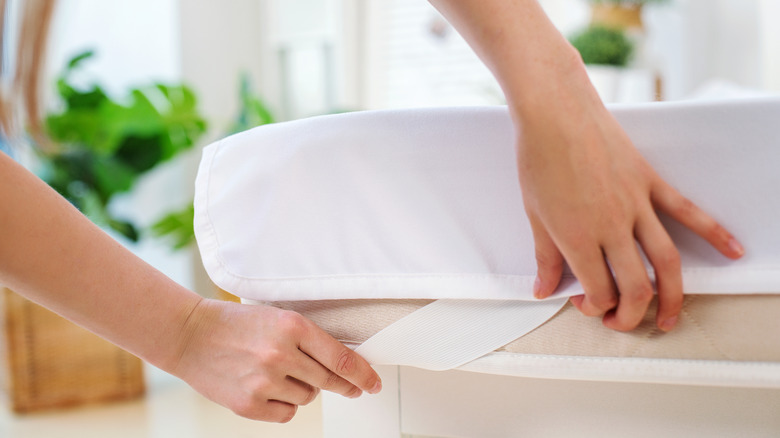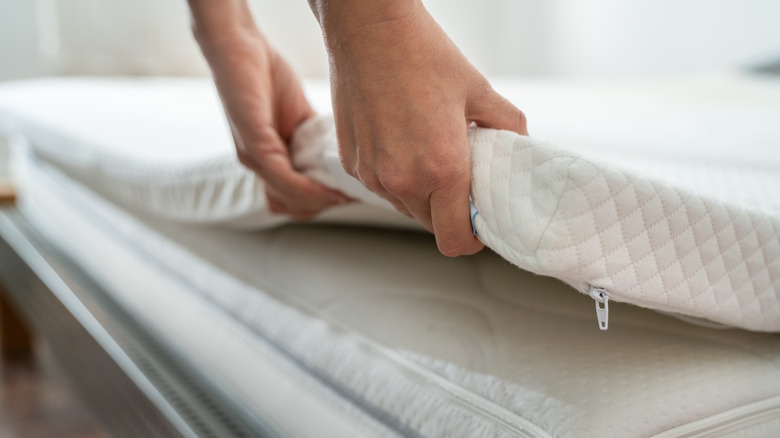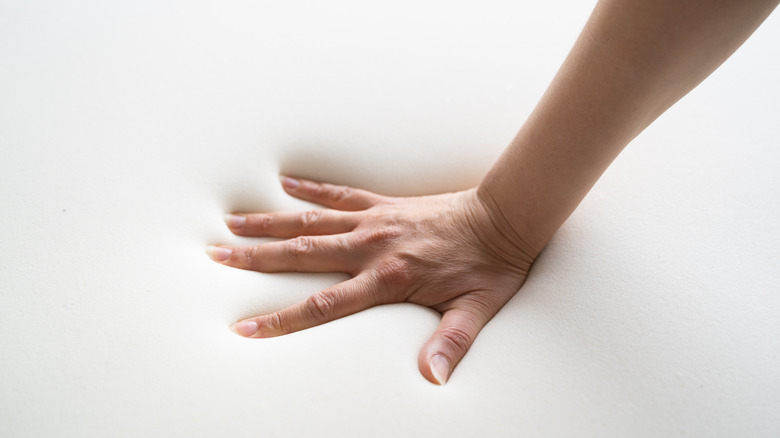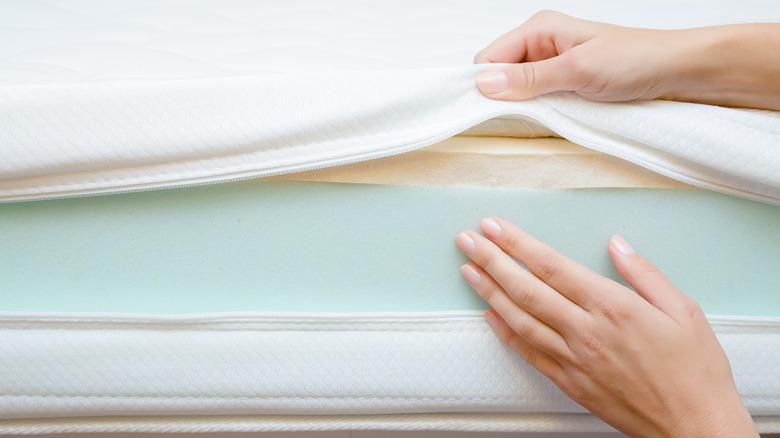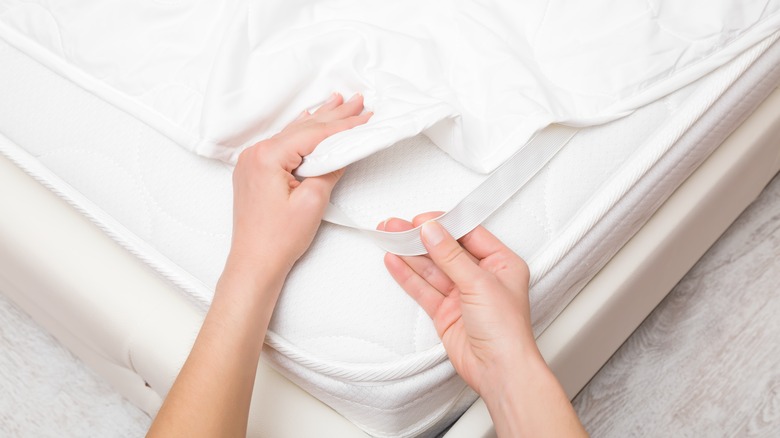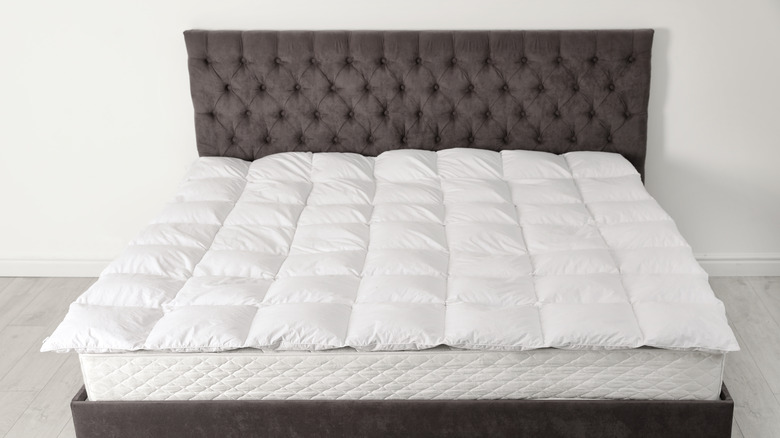Mattress Toppers: Everything You Need To Know Before You Buy
Do you think it's time to replace your mattress? If so, you should consider shopping for a mattress topper instead. A topper is an extra layer that is placed on top of your current mattress. They come in a wide variety of materials, thicknesses, and designs and can serve many different purposes. The primary function is to provide extra cushioning, but they can also be used to make a mattress softer or firmer, provide a cooling effect, or help hide the signs of wear on your existing mattress, according to Living Spaces.
Buying a mattress topper is much more affordable than replacing your mattress altogether, but can make your bed feel brand new. These mattress accessories can help alleviate strain on pressure points, maintain a consistent sleep temperature, and generally make for a more comfortable sleep experience, according to Time4Sleep. But as with all items in your home, shopping for the right one requires a bit of research. To help with this process, use the following guide to discover everything you need to know about mattress toppers.
What is a mattress topper?
A mattress topper (or mattress pad) is a removable bedding item placed on top of a mattress, usually to provide an additional layer of comfort or firmness. According to Polysleep, a mattress topper is different from a mattress cover, which acts as a protective layer to prevent your mattress from becoming stained or soiled. Covers are also typically designed to protect against dust mites. Unlike a mattress topper, a mattress cover does not add any cushioning.
A mattress topper is a thick, padded layer of material that sits right on top of your mattress and underneath your bedding. The purpose of a topper is to add comfort, support, and additional cushioning (via Ecosa). They come in varying thicknesses, materials, and sizes, so you can find one that perfectly fits your needs. Mattress toppers are also extremely versatile — they'll work with any type of mattress, from foam mattresses to pillow tops to spring mattresses. Not only do they add extra cushioning for better comfort, but they also help protect your current mattress from wear and tear.
Mattress toppers are used for many reasons, but primarily they can improve the comfort level of your bed without the hassle or expense of buying a whole new mattress. They make great temporary solutions for those who are planning to buy a new mattress in the near future but want to get more use from their old one before making a new purchase.
Mattress topper materials
Mattress toppers come in a variety of materials and construction types, each with pros and cons.
Polyurethane foam is the most common material used for mattress toppers. Use it to add a bit of firmness to a mattress that's too soft or adding extra cushioning to a mattress that's too firm. It's affordable but isn't the most durable option.
Memory foam is one of the most popular options. They conform to the body, allowing for better sleep alignment, according to Good Housekeeping. They're made from polyurethane foam but include additional chemicals to improve density, softness, and springiness. Memory foam does retain heat, making it uncomfortable for hot sleepers. However, some contain gel particles that help regulate temperature by absorbing body heat and providing a cooling effect.
Latex mattress toppers are considered eco-friendly because they're made from natural rubber, according to Mattress Nut. There are different firmness levels available. Softer formulations feel more like memory foam, while firmer ones feel similar to innerspring mattresses. They are typically designed with pinholes to allow for greater airflow for temperature regulation.
Down and down alternatives are both excellent choices for those who want a plush feel. Down is made from the soft underlayer of feathers found on geese and ducks, while down alternative is a synthetic product that acts much like down does but at a lower price point. If you want a softer surface for sleeping, either of these options will work well for you.
What to consider when shopping for a mattress topper
The most important factor when shopping for a mattress topper is to keep in mind is the size of your mattress. You should make sure that the mattress protector that you choose will fit onto your bed properly. Typically, mattress toppers are sold in sizes that correspond to standard bed sizes like twin, full, queen, and king. To be safe, measure the dimensions of your bed before buying so that you can find one that will fit properly, suggested Casper.
Thickness is another primary consideration when choosing a mattress topper. The thickness can vary from 2 inches to 4 inches, which is the maximum thickness without disturbing fitted sheets. If you choose a thick mattress topper, it may be necessary to upgrade to deep pocket sheets for proper fit.
Choose a topper with the density that best suits your needs. Topper density is measured by how many pounds of weight the topper can support per cubic foot. The higher the density, the more supportive the topper. High-density toppers are more expensive than low-density ones but also more durable. Low-density toppers tend to "bottom out" after a year or two, making them uncomfortable and lumpy.
When shopping for a down or feather mattress topper, consider the product's fill power. Fill power determines how fluffy it will be — the higher the fill power, the fluffier the topper, according to REI.
How to clean a mattress topper
Wash your mattress topper two to three times each year, suggested the Sleep Foundation. To ensure your topper lasts as long as possible always follow the manufacturer's instructions when cleaning it. If your mattress topper doesn't come with specific cleaning instructions, here are some general guidelines.
Start by taking off the cover. Skip this step if your topper doesn't have a cover. For regular cleaning, put the cover on a delicate wash cycle and air dry it. For more stubborn stains, use the standard stain removal methods you'd employ for stains on sheets and other bedding.
Most mattress toppers can go in the washing machine, but Beloit Mattress reminded the importance of reading care labels. In general, synthetic materials like polyester and memory foam can be washed in the machine on a cold cycle with gentle detergent. Cotton or down mattress toppers can similarly be washed on a medium cycle with mild detergent. Dry your topper straight away, either by laying it flat in the sun or tumble drying on a low heat setting.
If you don't want to machine wash your topper, you can use a vacuum cleaner with a brush head attachment to remove dirt and other debris from the surface. Use the upholstery wand if your vacuum doesn't have an upholstery attachment. Use an enzymatic cleaner or oxygen bleach, if recommended, to treat stains without damaging or discoloring the fabric. You can also spot clean with baking soda or white vinegar.
How much do mattress toppers cost?
Mattress toppers vary widely in price, but across the board, they're much less expensive than investing in a brand new mattress. Generally speaking, mattress toppers usually range from $150 to $450, though more expensive options can cost more than $500, according to The Sleep Foundation. The price of a mattress topper depends on its type, size, and material. When shopping for a mattress topper, you'll want to consider what's most important in your sleep experience—whether it's pressure relief, temperature control, or comfort—and find the best mattress topper that meets your needs.
Polyurethane foam mattress toppers are the most affordable, but they're also among the least durable options, lasting an average of one year before it starts breaking down and losing their shape.
Memory foam is a polyurethane product with additional chemicals added for density, softness, and springiness. This makes it more durable than polyurethane foam but also more expensive—models usually cost between $70 and $300 for a queen size, according to Terry Cralle.
If you are in the market for a mattress topper, hopefully, we've helped you make an informed and educated decision. The best one for you might depend on your personal preferences, sleeping patterns, and of course, budget.
